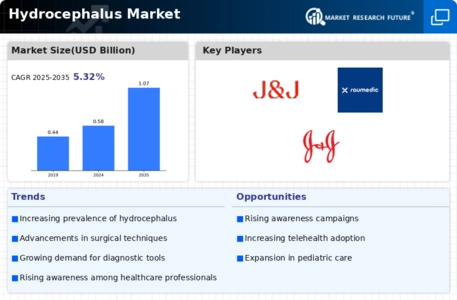Hydrocephalus Size
Hydrocephalus Market Growth Projections and Opportunities
Hydrocephalus, a condition characterized by the accumulation of cerebrospinal fluid within the brain's ventricles, poses significant medical challenges. As we delve into the market factors influencing the management and treatment of hydrocephalus, several key elements come into play. Firstly, the prevalence of hydrocephalus impacts market dynamics significantly. This condition affects individuals across all age groups, from infants to older adults. The incidence rates vary, with congenital cases often diagnosed shortly after birth, while acquired hydrocephalus may develop at any point in life due to factors such as tumors, infections, or traumatic brain injury. Understanding these demographics helps shape the market's scope, driving research, innovation, and healthcare resource allocation.
Secondly, advancements in medical technology and treatment modalities play a crucial role in shaping the hydrocephalus market. Traditional treatments such as shunt systems have long been the primary method for managing hydrocephalus by diverting excess cerebrospinal fluid away from the brain to other parts of the body where it can be absorbed. However, shunts are associated with complications such as infections, blockages, and mechanical failures, prompting ongoing efforts to develop more effective alternatives. Emerging technologies, including minimally invasive endoscopic procedures and innovative shunt designs, are poised to revolutionize hydrocephalus management, offering patients and healthcare providers safer and more reliable treatment options.
Market factors are also influenced by regulatory frameworks and healthcare policies governing the approval, reimbursement, and accessibility of hydrocephalus treatments. Regulatory agencies such as the Food and Drug Administration (FDA) in the United States and the European Medicines Agency (EMA) in Europe play pivotal roles in evaluating the safety and efficacy of medical devices and pharmaceuticals intended for hydrocephalus management. Furthermore, reimbursement policies set by government payers, private insurers, and healthcare systems influence the adoption and utilization of innovative treatments, shaping market dynamics and industry strategies.
Moreover, the global healthcare landscape, including economic conditions, healthcare infrastructure, and access to specialized care, profoundly impacts the hydrocephalus market. Disparities in healthcare resources and access to neurosurgical expertise contribute to variations in treatment outcomes and patient experiences worldwide. In regions with limited healthcare infrastructure, challenges such as underdiagnosis, delayed interventions, and inadequate follow-up care pose significant obstacles to effective hydrocephalus management. Addressing these disparities requires collaborative efforts among healthcare stakeholders, policymakers, and advocacy organizations to improve awareness, education, and access to quality care for individuals affected by hydrocephalus.
Additionally, research and development (R&D) initiatives drive innovation and therapeutic advancements in the hydrocephalus market. Academic institutions, pharmaceutical companies, and medical device manufacturers invest in R&D efforts aimed at elucidating the underlying mechanisms of hydrocephalus, exploring novel treatment targets, and enhancing existing therapeutic modalities. Collaborative research networks and clinical trials play pivotal roles in evaluating the safety, efficacy, and long-term outcomes of experimental therapies, paving the way for evidence-based clinical practice and regulatory decision-making.
Furthermore, patient advocacy and community engagement initiatives exert significant influence on the hydrocephalus market. Patient advocacy organizations, support groups, and online communities empower individuals living with hydrocephalus and their caregivers by providing education, resources, and a platform for shared experiences. These grassroots efforts raise awareness, drive research funding, and advocate for policies that prioritize the needs and well-being of individuals affected by hydrocephalus. By amplifying patient voices and fostering collaboration among stakeholders, advocacy efforts contribute to a more patient-centered approach to hydrocephalus care and research.







Leave a Comment